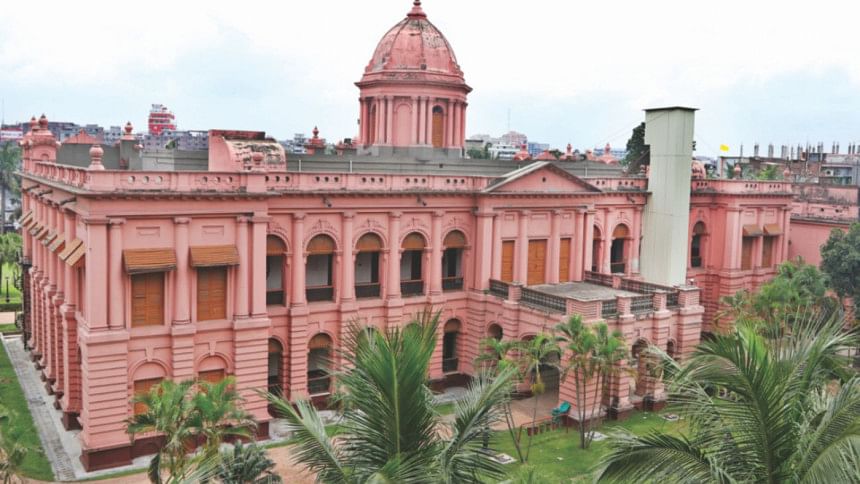No ahsan at the manzil

JUST as we do not like to have shik kabab with Chinese noodles (hopefully I am right), or expect someone to wear a red tie over his white Panjabi (undeniably eye-catching), or go swimming voluntarily in a lounge suit(pushing not included), there is no degree of sanity from even the intellectual level of a six-year old (make it sixteen) in erecting agrotesque elevator shaft that has completely ruined the aesthetics of Dhaka's Ahsan Manzil at Kumartuli, a heritage building of 1872 protected by law, but unprotected by the very guardians of the edifice. The two-storied stately palace and kachari of the then Dhaka's Nawab family, dubbed the Pink Palace at one time, is a public museum for almost a quarter of a century.
The building's era and history, pomp and grandeur was recognised by the Nagar Unnayan (city development) Committee, which on February 12 2009, under Section 61 of the Dhaka Metropolis Building Construction Rules, 2008, recorded Ahsan Manzil at serial # 52 among 93 buildings of historical, aesthetic, scientific, social, and/or religious importancewhich must be protected/ preserved/ conserved.
No thanks to the building'scustodian, the Bangladesh National Museum authority for defending their unsightly lofty act (against the above order) as 'a service to the disabled'. If the rakkhak have tried to fulfil one government order (i.e. ensuring universal accessibility), surely they have turned vakkhak in appending a lift in the ugliest possible way. Perhaps we will all agree, given their aristocratictaste of the bygone times, that the nawabs of the early part of the last century would consider it blasphemous to witness today the unannounced hobnobbing of a concrete obelisk with this building of eclectic excellence, replete with memories of their ayeshi lifestyle.
The archaeology department deserves no kudos either for trying to shelve responsibility by stating that 'the (national) museum authorities were in charge since the renovation of the edifice in (September) 1992'. But, Sir, it is the duty of the archaeology department to stop any person/s, including any from within its ranks, who attempts to 'alter' or 'deface' an antiquity that is 133 years old, by which measure Ahsan Manzil should be listed under the Antiquities Act, 1968. Section 19 of the 1968 Act spells out: "…no person shall, except for carrying out the purposes of this Act, destroy, break, damage, alter, injure, deface or mutilate, or scribble, write or engrave any inscription or sign on any antiquity in respect of which the Director has accepted guardianship or the Government has acquired any right." But, the building has been, to use cliché, raped in broad daylight.
By law, every building must be provided with ease of access for all. Section 64 of the Dhaka Metropolis Building Construction Rules, 2008 states: ". . . accessibility for the disabled and all others must essentially be ensured." That being understood and to abide by the law of protecting antiquity, i.e. without disfiguring the building, all that the museum authority had to do was in keeping with the 2008 Rules (a) contract an Architect, (b) help that Architect find a suitable place inside the building for locating the lift, such that the mechanical contraption would not be so loudly and conspicuously visible from the outside, (c) engage qualified Mechanical and Electrical engineers to prepare the relevant drawings, and (d) in consultation with the consultants try to study if using glass surfaces around the lift, if absolutely essential to locate it outside the building, would have made the visual atrocity less unsightly, obnoxious and revolting.
We are assuming that the National Museum authority did not take the necessary Building Permit from RAJUK, which certificationas per the 2008 Rules, is required for any alteration, extension, or addition to anybuilding.The authority should have ensured that all construction drawings are approved.
For the safety of the almost century-and-a-half building that bears the legacy of the ruling class, the structural design of the loathsome shaft should have been prepared by an engineer. This requirement perhaps has been violated because any structural engineer worth his salt would demand an architectural drawing. The drawings for mechanical and electrical services are also required to be prepared by relevant professionals as listed in Clause 41 of the 2008 Rules. Is there an architect, or are there engineers? Was the construction of the shaft supervised?
Ahsan Manzil is an architectural masterpiece of its times and is the silent witness to many historical events. "From the last part of the 19th century to the initial years of Pakistan, the Muslim leadership of East Bengal emerged from this palace. The nawabs of Dhaka used to conduct their court affairs here as chief of the panchayet (village council) everyday. Many anti-Congress meetings were held here under the patronization of Nawab Ahsanullah, a staunch believer in Muslim identity. Almost all the Viceroys, Governors and Lieutenant Governors of British India who visited Dhaka spent some time at the Ahsan Manzil."
Bangabandhu also recognised the importance of the building, being himself aware of the political history of the period, and it is said that he not only cancelled a proposal for its auction, "but on 2 November 1974, he ordered to establish a museum and tourist centre after its proper conservation." Now such a significant part of our history stands defaced on the bank of the River Buriganga.
Relevant authorities, including the Nagar Unnayan Committee, should adopt urgent measures to remove the horrid shaft that violates the sanctity of the building's riverside façade, and find appropriate means to address the need of the disabled. To pre-empt such disasters, the government should consider appointing officers with adequate pertinent knowledge in such sensitive places. Just anybody cannot protect a protected monument.
The writer is a practising Architect at BashaBari Ltd., a Commonwealth Scholar and a Fellow, a Baden-Powell Fellow Scout Leader, and a Multiple Paul Harris Fellow-cum-Benefactor Rotarian.

 For all latest news, follow The Daily Star's Google News channel.
For all latest news, follow The Daily Star's Google News channel. 



Comments